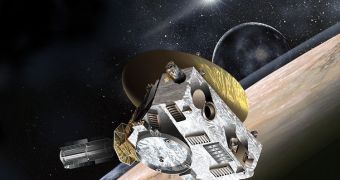Astronomers interested in discovering whether an ocean lies just underneath the crusty surface of Pluto have to wait for about 3 more years. The NASA New Horizons spacecraft is currently on its way to the dwarf planet, and it is scheduled to fly past the object in 2015.
This probe is the fastest ever built. Launched in early 2006, it will take only 9 years to reach Pluto, whereas the Cassini probe took 7 years to reach the gas giant Saturn. It represents the first foray NASA made with an explorations spacecraft this far out into the solar system.
While the Pioneer and Voyager spacecraft did move farther out into space, their goal was not to investigate dwarf planets and trans-Neptunian objects, or the Kuiper Belt. New Horizons was built specifically to analyze these space bodies, and learn as much about them as possible.
The vehicle will not enter orbit around Pluto, but will rather fly very close to the Plutonian system, which includes the dwarf planet and four moons. This flight will enable the advanced instruments aboard the spacecraft to image each of these objects many times, providing a wealth of data.
One of the things researchers will be looking for is establishing whether an ocean can exist beneath the dwarf planet's surface. The latter is made up of a thin shell of nitrogen ice, under which important amounts of water-ice may lie, Space reports.
Testing to see whether this is true or not is impossible using telescopes or other Earth- and orbit-based scientific instruments. However, New Horizons does carry with it the necessary tools to identify such a formation, if one is to be found at all.
Recent investigations have uncovered that the existence of an ocean under Pluto's thin crust is very likely. The same studies have also indicated some of the telltale signs the NASA spacecraft could look for in its quest to test this theory.
The latest study conducted on this issue was carried out by investigators at the University of California in Santa Cruz (UCSC), who were led by planetary scientists Guillaume Robuchon and Francis Nimmo.
In order to test the prediction, the team used a model of how the dwarf planet evolved since its creation. They determined that one of the signs indicating the presence of an ocean would be the absence of an equatorial bulge.
Such a structure – which would be about 10 kilometers (6 miles) high in Pluto's case – is formed from material pushed towards the Equator by the angular momentum of the planet. If this feature does not exist, then it could very well be that Pluto does have an ocean.

 14 DAY TRIAL //
14 DAY TRIAL //